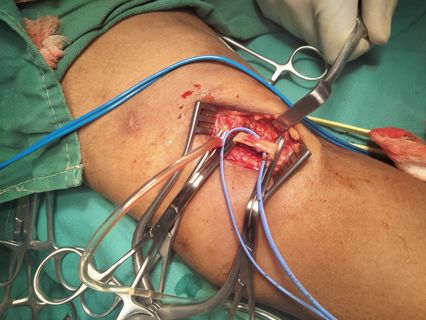
A double arteriotomy is a complex vascular surgical procedure that involves making two incisions into an artery. This technique is employed to access the lumen of the artery for diagnostic or therapeutic purposes, such as removing blockages, repairing damaged sections, or facilitating bypass procedures. The procedure requires careful planning and execution due to the risks associated with arterial surgery, including damage posterior wall and damage to surrounding tissues.
Indications
Double arteriotomy is indicated in several clinical scenarios. One primary indication is the AVF double arteriotomy may be employed during bypass surgeries, where it provides access points for grafting vessels to reroute blood flow around obstructed or damaged segments of an artery.
Procedure
The procedure for a double arteriotomy typically involves several steps, performed under general or regional anesthesia. First, the surgeon makes an initial incision in the skin and subcutaneous tissues to expose the target artery. Once the artery is isolated, two longitudinal arteriotomies are made, providing access to the interior of the vessel. The precise location and length of the incisions depend on the specific pathology being addressed and the artery involved.
During bypass surgeries, the arteriotomies serve as sites for the anastomosis, where grafts are sewn to the artery to create a new pathway for blood flow.
After the necessary repairs or interventions are completed, the arteriotomies are carefully closed with fine sutures to ensure hemostasis and restore the integrity of the arterial wall. The surrounding tissues and skin are then closed in layers, and a sterile dressing is applied to the surgical site.
Recovery
Recovery from a double arteriotomy varies depending on the complexity of the procedure and the patient’s overall health. Postoperative care involves monitoring for potential complications, such as bleeding, infection, or thrombosis at the surgical site. Patients may require anticoagulant or antiplatelet medications to prevent clot formation and ensure optimal blood flow through the treated artery.
Pain management is also an important aspect of recovery, and patients may be prescribed analgesics to alleviate discomfort. Gradual mobilization and physical therapy can help improve circulation and facilitate the healing process. Follow-up appointments are crucial for assessing the success of the procedure and monitoring for any signs of recurrent arterial disease.
### Risks and Considerations
Like all surgical procedures, double arteriotomy carries risks. These include potential damage to the artery or surrounding structures, postoperative bleeding, infection, The risk of complications is higher in patients with comorbid conditions such as diabetes, hypertension, or chronic kidney disease.
In conclusion, a double arteriotomy is a vital surgical technique used to address various arterial pathologies. Its successful execution requires meticulous surgical skill and comprehensive postoperative care to minimize risks and promote optimal patient outcomes. As with any medical procedure, thorough patient assessment and careful consideration of indications are essential to achieving the best possible results.
Noshad khanさんをフォローして最新の投稿をチェックしよう!
0 件のコメント
この投稿にコメントしよう!
この投稿にはまだコメントがありません。
ぜひあなたの声を聞かせてください。
